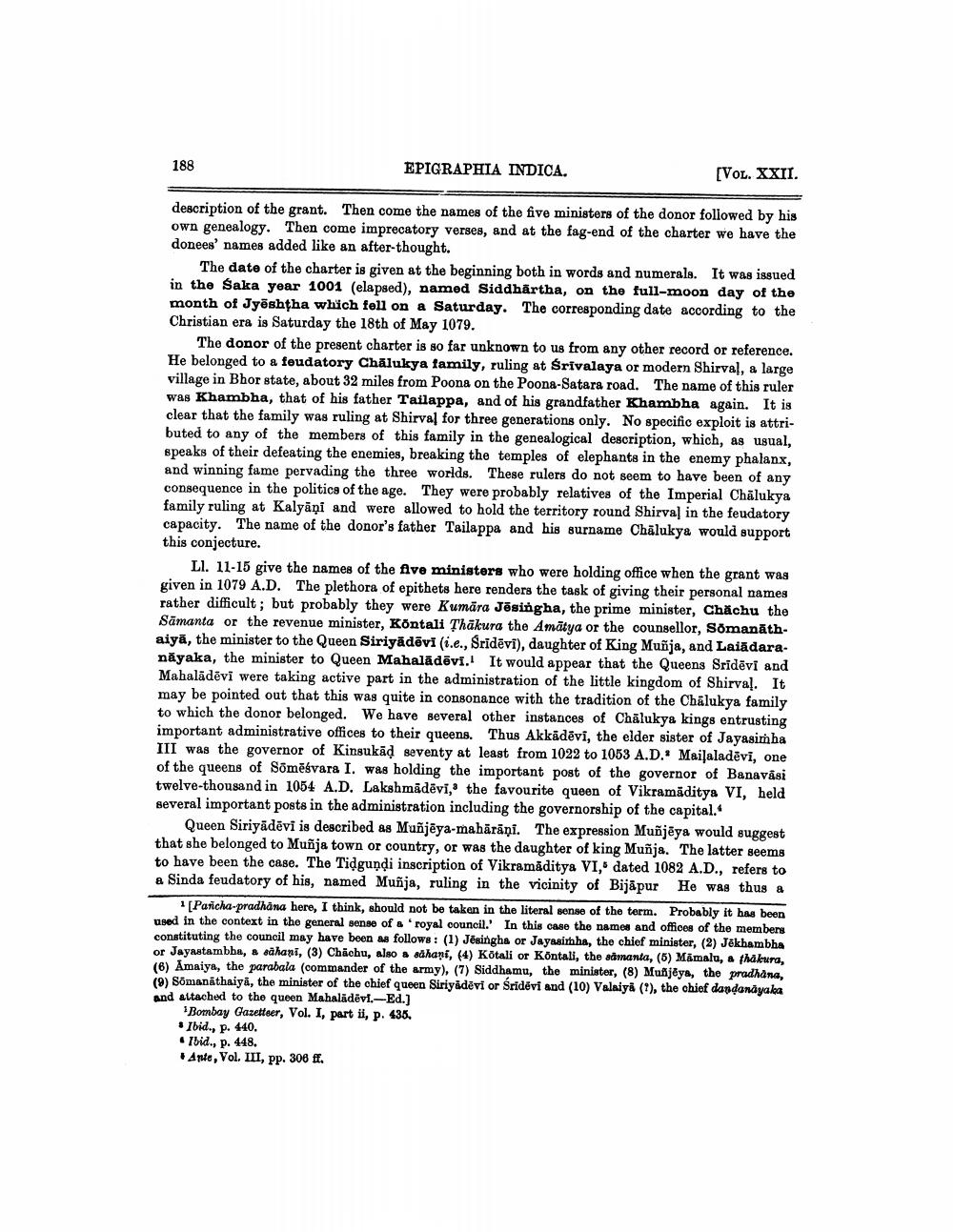________________
188
EPIGRAPHIA INDICA.
[VOL. XXII.
description of the grant. Then come the names of the five ministers of the donor followed by his own genealogy. Then come imprecatory verses, and at the fag-end of the charter we have the donees' names added like an after-thought.
The date of the charter is given at the beginning both in words and numerals. It was issued in the Saka year 1001 (elapsed), named Siddhārtha, on the full-moon day of the month of Jyēshtha which fell on a Saturday. The corresponding date according to the Christian era is Saturday the 18th of May 1079.
The donor of the present charter is so far unknown to us from any other record or reference. He belonged to a feudatory Chalukya family, ruling at Śrivalaya or modern Shirval, a large village in Bhor state, about 32 miles from Poona on the Poona-Satara road. The name of this ruler was Khambha, that of his father Tailappa, and of his grandfather Khambha again. It is clear that the family was ruling at Shirval for three generations only. No specific exploit is attributed to any of the members of this family in the genealogical description, which, as usual, speaks of their defeating the enemies, breaking the temples of elephants in the enemy phalanx, and winning fame pervading the three worlds. These rulers do not seem to have been of any consequence in the politics of the age. They were probably relatives of the Imperial Chalukya family ruling at Kalyani and were allowed to hold the territory round Shirval in the feudatory capacity. The name of the donor's father Tailappa and his surname Chālukya would support this conjecture.
Ll. 11-15 give the names of the five ministers who were holding office when the grant was given in 1079 A.D. The plethora of epithets here renders the task of giving their personal names rather difficult; but probably they were Kumāra Jēsingha, the prime minister, Chăchu the Sämanta or the revenue minister, Kontali Thākura the Amātya or the counsellor, Somanāthaiyā, the minister to the Queen Siriyadēvi (i.e., Sridevi), daughter of King Muñja, and Laiādaranāyaka, the minister to Queen Mahalādēvi.! It would appear that the Queens Sridevi and Mahalādēvi were taking active part in the administration of the little kingdom of Shirval. It may be pointed out that this was quite in consonance with the tradition of the Chalukya family to which the donor belonged. We have several other instances of Chalukya kings entrusting important administrative offices to their queens. Thus Akkādēvi, the elder sister of Jayasimha III was the governor of Kingukād seventy at least from 1022 to 1053 A.D.Maijaladēvi, one of the queens of Somēśvara I. was holding the important post of the governor of Banavasi twelve-thousand in 1054 A.D. Lakshmädēvi," the favourite queen of Vikramaditya VI, held several important posts in the administration including the governorship of the capital..
Queen Siriyādēvi is described as Muñjēya-mahāräni. The expression Muñjēga would suggest that she belonged to Muñja town or country, or was the daughter of king Muñja. The latter seems to have been the case. The Tidgundi inscription of Vikramaditya VI, dated 1082 A.D., refers to a Sinda feudatory of his, named Muñja, ruling in the vicinity of Bijāpur He was thus a
1 [Paricha-pradhana here, I think, should not be taken in the literal sense of the term. Probably it has been used in the context in the general sense of & 'royal council.' In this case the names and offices of the members constituting the council may have been follows: (1) Jēsingha or Jayasinha, the chief minister, (2) Jēkhambha or Jayastambba, & sähani, (3) Chachu, also a sahani, (4) Kotali or Kontali, the samanta, (5) Māmalu, a thakura, (6) Amaiya, the parabala (commander of the army), (7) Siddhamu, the minister, (8) Muñjéya, the pradhana, (9) Sõmanāthaiya, the minister of the chief queen Siriyadēvi or Sridevi and (10) Valaiya (*), the chief dandanayaka and attached to the queen Mahalādēvi.-Ed.]
Bombay Gazetteer, Vol. I, part i, p. 435. • Ibid., p. 440. . Ibid., p. 448. Ante, Vol. III, pp. 308 ff.




